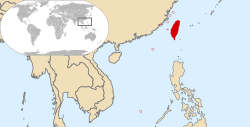User:Oeides/sandbox
24°N 121°E / 24°N 121°E {{Infobox country | conventional_long_name = Republic of China | common_name = Taiwan
| native_name =
| image_flag = Flag of the Republic of China.svg | alt_flag = A red flag, with a small blue rectangle in the top left hand corner on which sits a white sun composed of a circle surrounded by 12 rays. | flag_type = Flag | image_coat = National Emblem of the Republic of China.svg | alt_coat = A blue circular emblem on which sits a white sun composed of a circle surrounded by 12 rays.
| other_symbol = National seal:
中華民國之璽
Seal of the Republic of China
National flower:
梅花
Plum blossom![]()
| symbol_type = Emblem
| national_anthem =
中華民國國歌
Zhōnghuá Mínguó Guógē
"National Anthem of the Republic of China"
| flag_anthem =
中華民國國旗歌
Zhōnghuá Míngúo Gúoqígē
"National Flag Anthem of the Republic of China"
| image_map =
| map_caption = | largest_city = New Taipei City | capital = Taipei[a][2] | coordinates = 25°04′N 121°31′E / 25.067°N 121.517°E | ethnic_groups_year = 2016 | ethnic_groups_ref = [3]
| ethnic_groups =
- 95–97% Han Taiwanese
- 2.3% Indigenous[b]
- 0.7–2.7% Others
| official_languages = Standard Chinese[c][6][7][8] | languages_type = Official script | languages = Traditional Chinese[9] | languages2_type = National languages[d]
| languages2 =
Cite error: There are <ref group=upper-roman> tags on this page, but the references will not show without a {{reflist|group=upper-roman}} template (see the help page).
- ^ "Since the implementation of the Act Governing Principles for Editing Geographical Educational Texts (地理敎科書編審原則) in 1997, the guiding principle for all maps in geographical textbooks was that Taipei was to be marked as the capital with a label stating: "Location of the Central Government"". 4 December 2013. Archived from the original on 1 November 2019. Retrieved 1 November 2019.
- ^ "Interior minister reaffirms Taipei is ROC's capital". Taipei Times. 5 December 2013. Retrieved 7 December 2013.
- ^ The Republic of China Yearbook 2016. Executive Yuan, R.O.C. 2016. p. 10. ISBN 9789860499490. Retrieved 31 May 2020.
Ethnicity: 70 percent Hoklo; 15 percent Hakka 10–15 percent mainlanders; 2 percent indigenous Austronesian peoples
- ^ "推動雙語國家政策問題研析". www.ly.gov.tw (in Chinese). 23 July 2013. Retrieved 25 May 2021.
- ^ "法律統一用語表-常見公文用語說明" (PDF) (in Chinese). Archived from the original (PDF) on 2 June 2021. Retrieved 2 June 2021.
- ^ Executive Yuan, R.O.C. (Taiwan) (2012). "Chapter 2: People and Language". The Republic of China Yearbook 2012. p. 24. ISBN 9789860345902. Archived from the original on 14 October 2013. Retrieved 18 December 2013.
- ^ Government Information Office (2010). "Chapter 2: People and Language" (PDF). The Republic of China Yearbook 2010. p. 42. ISBN 9789860252781. Archived from the original (PDF) on 5 August 2011.
- ^ Liao, Silvie (2008). "A Perceptual Dialect Study of Taiwan Mandarin: Language Attitudes in the Era of Political Battle". In Chan, Marjorie K. M.; Kang, Hana (eds.). Proceedings of the 20th North American Conference on Chinese Linguistics (NACCL-20) (PDF). Vol. 1. Columbus, Ohio: The Ohio State University. p. 393. ISBN 9780982471500. Archived from the original (PDF) on 24 December 2013.
- ^ "行政院第3251次院會決議". www.ey.gov.tw (in Chinese). Retrieved 25 May 2021.
- ^ 國家語言發展法. law.moj.gov.tw (in Chinese). Retrieved 22 May 2019.
- ^ "Hakka Basic Act". law.moj.gov.tw. Retrieved 22 May 2019.
- ^ "Indigenous Languages Development Act". law.moj.gov.tw. Retrieved 22 May 2019.
Cite error: There are <ref group=lower-alpha> tags or {{efn}} templates on this page, but the references will not show without a {{reflist|group=lower-alpha}} template or {{notelist}} template (see the help page).




